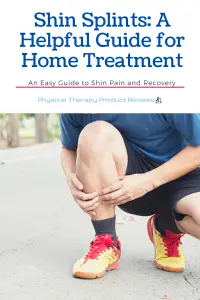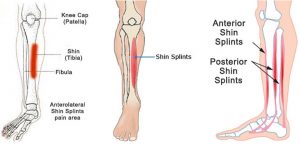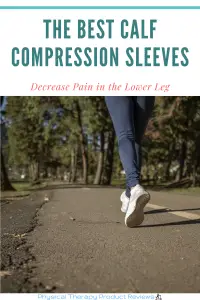Rehabbing Shin Splints at Home
 Medial tibial stress syndrome (MTSS), which is colloquially known as “shin splints” is one of the most common lower extremity injuries, especially in runners and other impact athletes.1 The prevalence ranges from 13% to 35% in these specific populations.2 The nature of the injury involves microdamage to the Tibia over time.3 This comes as a frustration to many patients since the nature of the condition means that there is no quick fix to undo the chronic damage that has accumulated. Because shin splints are an early stress reaction that could lead to more serious stress fractures, later on, it is critical to understand why this condition occurs and how to prevent and/or treat it at home.
Medial tibial stress syndrome (MTSS), which is colloquially known as “shin splints” is one of the most common lower extremity injuries, especially in runners and other impact athletes.1 The prevalence ranges from 13% to 35% in these specific populations.2 The nature of the injury involves microdamage to the Tibia over time.3 This comes as a frustration to many patients since the nature of the condition means that there is no quick fix to undo the chronic damage that has accumulated. Because shin splints are an early stress reaction that could lead to more serious stress fractures, later on, it is critical to understand why this condition occurs and how to prevent and/or treat it at home.
What are Shin Splints?
Symptoms
Shin splints are, very simply, a condition of overuse.2 For those who have experienced this condition, the symptoms are hard to forget. However, for all who have been fortunate enough to avoid the wrath of MTSS, there are several key features that you should look out for. As the name suggests, this condition refers to exercise-induced pain over the tibia (shinbone).2 Specifically, most patients experience pain along the inside edge of the tibia, though it may also develop along the outer edge as well.2 What sets this condition apart from others is the fact that it is exercise-induced, meaning the pain is provoked either during or after physical activity and may be reproduced when palpating the area.2 Unfortunately, there are no imaging tests that can definitively diagnose shin splints, but often imaging may be required in order to rule out more serious fractures or injuries.2

Pathophysiology
With increasing loads of weight, distance traveled, or impact exercises, the more stress we place on the tibia and the more microdamage accumulates in the tibial bone.3 As this microtrauma accumulates, inflammation develops around the bone injury.2 This area of inflammation also happens to correlate with areas of tendinous attachments of the soleus and posterior tibialis.2 This leads experts to believe that dysfunction of these muscles may also be implicated in shin splints.3
Epidemiology and Risk Factors
Because shin splints are caused by overuse of the lower extremities and recurrent impact exercises, runners, jumping athletes, and military personnel are especially prone to this condition.4,5 Other risk factors for developing shin splints include the female gender, a history of MTSS, high BMI, ankle and hip range of motion, and navicular drop (a measure that involves arch height and foot pronation).2 Interestingly, research has also noted that bone mineral density in the tibia may also predispose people to develop shin splints.3
Prognosis & Recovery
While shin splints can be quite disabling, it is often not a serious condition. In most cases, patients adhering to these conservative treatments and gradually re-integrating activities are expected to make a full recovery, though the time frame is broad.1
That being said, MTSS is, by definition, a stress reaction of the tibia due to overuse. There is always the possibility that it may progress to more serious complications if improperly treated, or not treated at all.
Need a calf compression sleeve? See our reviews of the best calf compression sleeves from Amazon.
How to Rehab from Shin Splints at Home?
To understand how to best go about treating shin splints, we must first understand the key elements involved and how they work together. When we are participating in impact activities, the tibia (shinbone) absorbs most of the shock and can slightly bend, much like a bridge that is under strain.6 This is where our calf muscles come in, which act like strong, supporting cables to counter the bending forces of the bridge (tibia).6 However, we want strong calf muscles, not tight ones. If the calf muscles are too tight, they will exert unnecessary tension on the already weakened tibia. Thus, shin splint rehabilitation should first focus on relaxing the muscles of the calf to eliminate this extra tension. Only then should you begin exercises to strengthen the calf muscles, which will help prevent the cycle from occurring all over again.
Rest
Most experts agree that rest is the most effective treatment for shin splints.1,7 Rest is critical to allow time for the tibia to heal and inflammation to subside. However, for some athletes, prolonged periods of rest is neither ideal nor feasible. In this case, some physicians may recommend “relative rest” by modifying activity duration, intensity, distance, etc.1
Hot Pack for Pain and Healing
Most previous literature suggests that cryotherapy (the therapeutic use of cooling/freezing temperatures) is the most effective method of treatment for injuries.1,7 However, research in recent years has suggested that thermotherapy (the therapeutic use of heat/hot temperatures) may be a better modality of treatment for particular injuries.8 While cold and heat treatments both decrease pain, heat treatment increases tissue metabolism, blood flow, and tissue stretchability, while cold therapy decreases these effects.8 We suggest placing hot packs to the lower leg, which will stimulate more blood flow and help to heal the tibia and surrounding areas. A great option for shin splints is the Inerzen Shin Splint and Calf Hot pack.
Why we like this product:
- Adjustable for all leg sizes and can tighten or loosen to your needs
- Remains hot for a long period of time
- Material is durable yet still breathable
Use an Arch Support to Limit Lower Leg Movement
Having curvature underneath your feet is a normal (and healthy) anatomic quality since this arch helps with shock absorption and energy transfer.9 Problems arise when this arch collapses, as it pulls on the muscles in the lower leg and causes an excessive force on our tibialis posterior muscle.10 Using arch support can help to lessen the burden on your tibia, allowing it to heal. We highly recommend Superfeet Arch support for their comfort and success.
Why we like this product:
- The product includes a stabilizer cap to the base of the insole, which provides extra support and stability
- Insole is made of high-density foam for maximum cushioning
- Incredibly durable and made with odor eliminating material
Compression Sleeves
Compression sleeves (or stockings) are designed to place most of the compression at the foot/ankle, and then gradually loosen as it moves up to the calf. The purpose of this is to increase venous return to the heart and reduce peripheral blood pooling and leg swelling.11 This promotes blood flow up to your shins (and even further up to your heart), which is beneficial for healing. Our favorite choice is Crucial Compression Calf Sleeves.
Why we like this product:
- Comes in two sizes to ensure the most appropriate fit for your calf size
- Soft and comfortable material that won’t irritate your skin
- High-quality stitching and product construction so that compression won’t diminish over time
Kinesio Tape for Pain
The Kinesio Taping method is an intentional taping technique that provides support and stability to muscles to promote the body’s natural rehabilitation process.12 Taping around certain muscles and joints targets somatosensory receptors to alleviate pain. By microscopically lifting the skin, Kinesio taping promotes lymphatic drainage, which decreases interstitial space and allows for inflammation to subside.12 As seen in this video, Kinesio taping around the posterior tibial tendon can greatly help to provide support and relief to the area
The Best Exercises To Heal and Prevent Shin Splints
Supplementing these above treatments with stretching and strength training, as well as low-impact cross-training, may help to expedite your recovery process.1 Below, we have gathered some of the best exercises to heal and prevent shin splints:
Foam Roll the Calf and the Whole Lower Leg
Goal: Loosen tired calf muscles to prevent injury and increase the localized blood flow for healing
Instructions:
- Begin seated on the ground
- Place foam roller underneath one calf
- With your arms behind you, slightly lift your buttocks just off the floor
- Gently roll your leg back and forth to massage the calf muscle
- Keep toe pointed upwards for full muscle release
- Turn foot outwards and continue rolling
- For a deeper release, roll with your legs crossed over each other
Eccentric Calf Raises with a Ball
Goal: Working the posterior tibialis will strengthen the calf muscles, which in turn supports the tibia
Instructions:
- While standing with feet together, place a tennis ball between your heels
- Lift up both heels while keeping the ball between your feet
- When lifting your heel, make sure to keep the pressure on the ball
- Push up through the big toes (weight on inner feet), rather than shifting your weight to the outside of your feet
- Slowly bring your heels to the ground
- Repeat ~20 times
- During the last repetition, lift your heels off the ground as normal
- Drop the ball
- Lift one leg off the ground and behind you (“Liftoff”)
- Maintain the calf raise on the other leg
- Ensure that you are keeping the weight on the inside of the planted foot
- Repeat on other foot
Seated Ankle Inversion with a Resistance Band
Goal: Strengthen tibialis posterior to improve foot arch collapse and strengthen calf muscles
- Begin by sitting on a bench/table with knees shoulder-width apart
- Designate one leg to start with
- Stabilize this leg by placing the contralateral forearm between the knees, and reinforcing with the ipsilateral hand
- Have another person place a resistance band around the designated foot and pull to full tension at a 45-degree angle
- The patient will slowly turn the designated foot outwards, and then turn inwards to starting position
- Wearing shoes or insoles is recommended for this exercise
Barefoot Single-leg Deadlift for Balance
Goal: Strengthen the calves and posterior tibialis. The unilateral nature of the exercise helps to restore muscle imbalances. By performing this barefoot, you will further strengthen the muscles of your foot and arch
Instructions:
- Begin standing upright
- Lift one knee forward to a 90-degree angle, and balance on the planted foot
- Slowly inch torso forward, making sure to bend at the hips and not at the waist
- Keep back neutral and straight
- Keep your lifted leg at a 90-degree angle, but allow the leg to move back with you
- Keep the toes of your lifted leg pointed at the ground
- Make sure the pelvis is neutral throughout the movement
- Do not open the hips
- Try to bend forward until your torso is almost parallel to the ground
- However, only bend forward until you feel your hips trying to open up
Conclusion:
Shin splints are an ever-common occurrence in the athletic world that halt many of us in our tracks. Though it can be frustrating to deal with such an injury-time after time, we hope that understanding the mechanisms by which this condition appears and the best therapeutic options may help to enhance your healing. Even better, we hope that this knowledge will allow you to take preventative measures so you never have to deal with that excruciating shin pain ever again!
Works Referenced:
- Galbraith, R.M., and Lavallee, M.E. (2009). Medial tibial stress syndrome: Conservative treatment options. Current Reviews in Musculoskeletal Medicine 2, 127–133.
- Reshef, N., and Guelich, D.R. (2012). Medial Tibial Stress Syndrome. Clinics in Sports Medicine 31, 273–290.
- Franklyn, M., and Oakes, B. (2015). Aetiology and mechanisms of injury in medial tibial stress syndrome: Current and future developments. World Journal of Orthopaedics 6, 577–589.
- Yates, B., and White, S. (2004). The Incidence and Risk Factors in the Development of Medial Tibial Stress Syndrome among Naval Recruits. American Journal of Sports Medicine 32, 772–780.
- Newman, P., Witchalls, J., Waddington, G., and Adams, R. (2013). Risk factors associated with medial tibial stress syndrome in runners: a systematic review and meta-analysis. Open Access Journal of Sports Medicine 4, 229.
- Davis, J. How Improving Calf Strength Can Fix Your Shin Splints.
- Beck, B.R. (1998). Tibial stress injuries. An aetiological review for the purposes of guiding management. Sports Medicine 26, 265–279.
- Nadler, S.F., Weingand, K., and Kruse, R.J. (2004). The physiologic basis and clinical applications of cryotherapy and thermotherapy for the pain practitioner. Pain Physician 7, 395–399.
- Nielsen, R.G., Rathleff, M.S., Simonsen, O.H., and Langberg, H. (2009). Determination of normal values for navicular drop during walking: A new model correcting for foot length and gender. Journal of Foot and Ankle Research 2, 12.
- Douglas Gross, K., Felson, D.T., Niu, J., Hunter, D.J., Guermazi, A., Roemer, F.W., Dufour, A.B., Gensure, E.H., and Hannan, M.T. (2011). Association of flat feet with knee pain and cartilage damage in older adults. Arthritis Care and Research 63, 937–944.
- Kerhervé, H.A., Samozino, P., Descombe, F., Pinay, M., Millet, G.Y., Pasqualini, M., and Rupp, T. (2017). Calf compression sleeves change biomechanics but not performance and physiological responses in trail running. Frontiers in Physiology 8.
- What is the Kinesio Taping Method? | Kinesio Tape.
Disclaimer: The information provided in this post is for educational purposes only. This is not a substitute for a medical appointment. Please refer to your physician before starting any exercise program.






